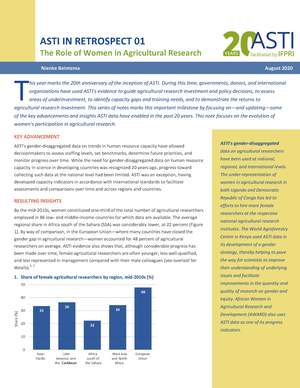Authors:
Nienke Beintema
Year:
2020
Publisher
International Food Policy Research Institute
Back to:
2020 marks the 20th anniversary of the inception of ASTI. To highlight this important milestone, the program released a Series of Notes focusing on—and updating—some of the key advancements and insights ASTI data have enabled in the past 20 years. This note focuses on the evolution of women’s participation in agricultural research.
ASTI’s gender-disaggregated data on trends in human resource capacity have allowed decisionmakers to assess staffing levels, set benchmarks, determine future priorities, and monitor progress over time. While the need for gender-disaggregated data on human resource capacity in science in developing countries was recognized 20 years ago, progress toward collecting such data at the national level had been limited. ASTI was an exception, having developed capacity indicators in accordance with international standards to facilitate assessments and comparisons over time and across regions and countries.
By the mid-2010s, women constituted one-third of the total number of agricultural researchers employed in 86 low- and middle-income countries for which data are available. The average regional share in Africa south of the Sahara (SSA) was considerably lower, at 22 percent. ASTI evidence also shows that, although considerable progress has been made over time, female agricultural researchers are often younger, less well-qualified, and less represented in management compared with their male colleagues (see overleaf for details).

